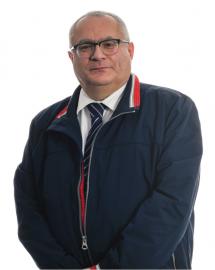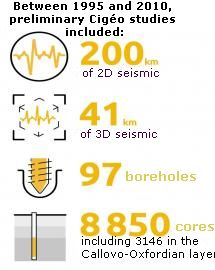30 years of scientific expertise at the service of the Cigéo project
For more than 30 years, Andra and its scientific partners have been studying the site selected to implement the Cigéo project, and more particularly the Callovo-Oxfordian (COx) clay layer, located at a depth of approximately 500 meters. The Agency now has very detailed knowledge of this geological layer, enabling the possibility to demonstrate the feasibility of geological disposal and the safety of the Cigéo project over the very long term. Interview with Frédéric Plas, Director of Research and Development at Andra.
How was the site for the Cigeo project chosen?

Frédéric Plas: This choice is the result of an approach that is both scientific and democratic. Under the 1991 Bataille Law (1), Andra was commissioned to assess the feasibility of disposal in different types of geological, clay or granite formations. We therefore studied four sites that applied for the mediation mission led by deputy Christian Bataille. These were three clayey sites in Meuse, Haute-Marne, and Gard, and one granite site in Vienne.
Preliminary geological surveys were undertaken between 1992 and 1996. This allowed us to file site authorization files for underground laboratories at each site. In 1998, after evaluating these files, the Government decided to retain the sites of Meuse and Haute-Marne in clay, then merged into a single site, and to abandon the sites of Gard and Vienne, in particular for scientific reasons.
For the Meuse / Haute-Marne site, it is a deep clayey geological layer, 160 million years old, known as the Callovo-Oxfordian (COx), which held our attention to study the feasibility of the realization of a storage.
What then were the steps to precisely identify the right location for deep storage?
FP: As soon as the authorization to create an underground laboratory on the Meuse / Haute-Marne site was granted, the investigations continued along two directions: on the one hand at the Underground Research Laboratory (URL), the construction of which was launched in 2000 to study in situ the clay layer and which reached the middle of the clay formation in 2004, and on the other hand additional investigations from the surface (drilling, seismic surveys).
Together, we have acquired more in-depth knowledge of the feasibility of repository in this layer, to guarantee the safety of the repository over the long term and of the capacity to build and operate a repository. In 2005, we thus established a complete report demonstrating this feasibility in principle. At that time, the area on which we had established this feasibility still represented an area of 250 km2 around the Underground Laboratory (transposition zone).
After the 2006 law (2), experiments in the Underground Laboratory continued and, in the field, in 2009, we tightened our investigations on a smaller area of approximately 30 km2: the ZIRA (for area of interest for detailed investigations).
Research thus continued, to consolidate our knowledge of the physical and chemical characteristics of the Callovo-Oxfordian layer, to specify the effects of disposal on this layer, in particular the thermal properties, and to gradually carry out demonstrators of the project's underground structures. Cigeo (galleries, disposal cells, seals) to bring us closer to the industrial dimension of disposal.
On what criteria was this layer of the Callovo-Oxfordian selected?
 F.P .: The selected layer is located at a depth of around 500 meters, which enables deep geological disposal to be sheltered from surface phenomena, such as long-term erosion. It is also very thick, about 140 to 160 meters. It also has a very low permeability and other interesting properties such as a high retention capacity thanks to clay minerals. These characteristics greatly limit the movement of radioactive elements from the repository to the surface, in particular by trapping most of the radionuclides in the repository and in its near field.
F.P .: The selected layer is located at a depth of around 500 meters, which enables deep geological disposal to be sheltered from surface phenomena, such as long-term erosion. It is also very thick, about 140 to 160 meters. It also has a very low permeability and other interesting properties such as a high retention capacity thanks to clay minerals. These characteristics greatly limit the movement of radioactive elements from the repository to the surface, in particular by trapping most of the radionuclides in the repository and in its near field.
All the parameters are in place to guarantee the fundamental objective of geological disposal, which is to protect people and the environment from the hazards of radioactive waste in the long term.
« "We have shown that we can build structures in this layer while retaining its properties" »
Do we still have uncertainties regarding the Meuse / Haute-Marne site? Are you continuing the research?
F.P. :Today, after 30 years of scientific work, the choice of geological disposal and the feasibility of the project have been acquired. Nevertheless, we are continuing studies in order to reduce uncertainties, increase safety margins and optimize disposal.
In particular, this involves refining our knowledge of certain properties of rock, such as its mechanical behavior, to consolidate its great robustness in the face of disposal stresses. We are also optimizing the design on other aspects such as the concrete liners, increasing the resistance of the structures to the mechanical stresses affecting the rock while limiting the liners thickness.
We are carrying out all this work with a number of scientific and technological partners of excellence (academic and research organizations in geosciences, such as the BRGM, underground work industry, etc.) but also with our Belgian and Swiss counterparts, who have also chose clay as the host rock for the repository and operate underground laboratories. All this also allows us to consolidate the progress of this project.
(1) This law relating to research into radioactive waste management established in particular a 15-year research program to consider a solution for the management of the most dangerous radioactive waste.
(2) In 2006, on the basis of scientific research carried out since 1991, Parliament endorsed the choice of deep disposal and instructed Andra to design Cigeo in Meuse / Haute-Marne.

